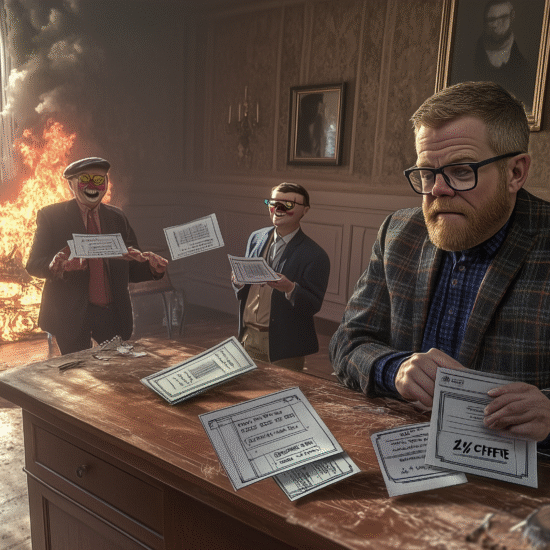🧨 Tased, Confused, and Prosecuted Anyway
Why Was Ian Cuypers Charged by the City Attorney and Not the DA?
Imagine this: You’re 22, driving DoorDash to pay your rent. You make a wrong turn down a one-way street in Superior, Wisconsin—land of grain elevators and “public safety” theater—and next thing you know, you’re getting tased like you’re trying to hijack Air Force One.
Enter Ian Cuypers, the latest poster child for how quickly a small-town traffic stop can go from mundane to mayhem—with the legal system playing whack-a-mole on your civil rights.
But here’s the million-volt question:
Why the hell was this case prosecuted by the City Attorney and not the District Attorney—especially when red flags were waving from the jump?
Let’s follow the juice.
⚖️ District Attorney vs. City Attorney: What’s the Difference, Anyway?
Let’s break it down Barney-style:
District Attorney (DA): Handles criminal cases—think felonies, serious misdemeanors, anything that might land you in prison or on a Netflix docuseries.
City Attorney: Handles municipal ordinance violations—basically adult detention slips. Think “don’t litter,” “no open containers,” and “stop resisting while we tase you repeatedly for not kneeling fast enough.”
Ian Cuypers was originally hit with:
Driving the wrong way (okay, fine—municipal ticket, sure).
Resisting or obstructing an officer (a.k.a. the catch-all cop ego insurance policy).
But here’s where things get real slimy:
Instead of pushing that resisting charge to the District Attorney—where the higher standard of proof and actual scrutiny might’ve nuked it—the city kept it in-house.
The result? Cuypers was prosecuted under a city ordinance, not state criminal law.
Why? Because it’s easier to win. And harder to prove police screwed up.
🧯 Warning Signs Were Everywhere
Let’s not act like this was a clean arrest.
Multiple officers with weapons drawn on a guy delivering tacos.
Conflicting commands shouted at a visibly confused driver.
Tased multiple times.
Bodycam footage reportedly raised eyebrows even inside SPD.
So here’s the thing: even SPD was apparently uneasy about the optics. Sources close to the department say concerns about “officer conduct” were raised right away. Some called the whole thing a “bad look.”
But instead of taking a breath and assessing the fallout, the City Attorney’s office doubled down, deciding to prosecute Cuypers under an ordinance that wouldn’t hold up in a real courtroom with a real judge applying the real rules of evidence.
Because here’s the dirty secret:
When the city prosecutes you for a municipal violation, you don’t get:
A jury trial (unless you raise hell).
A public defender by default.
The same level of procedural protection.
So it’s basically “court lite”—low-cal justice with all the accountability of a school lunch monitor.
🕵️ Translation: It Was a PR Move Disguised as Law
This wasn’t about “justice.” This was about CYA—Cover Your Arrests.
SPD knew it looked bad. The city knew it looked bad. But instead of admitting a mistake, they needed to justify the tasing. They needed Cuypers to be “resisting” so the taser wouldn’t seem like overkill.
So, what’s the game?
File under a city ordinance = less media attention.
Push the narrative of “noncompliance” = justify the force.
Win in local court = vindicate officers without real oversight.
Meanwhile, Cuypers’ life gets ripped up like a parking ticket in a snowstorm.
👨⚖️ Jury Saw Through It Anyway
Despite the city attorney’s best efforts, Cuypers was acquitted of the resisting/obstruction charge. A jury of his peers looked at the evidence and said:
“Yeah, nah—this ain’t it.”
Let that sink in. Even under the watered-down standards of a municipal court setup, the case still fell apart.
🤔 So… Why Would the City Prosecute This?
Let’s line up the reasons:
✅ To shield SPD from legal liability
If Cuypers is found guilty of resisting, it creates legal cover for tasing him. It also kneecaps any future civil-rights claims.
✅ To control the narrative
By keeping it in city court, they keep it small. Less attention. Less scrutiny. Less risk of bodycam footage being analyzed like the Zapruder film.
✅ To intimidate the victim
Being charged at all—even with something minor—puts the victim on defense. It’s a classic bully tactic. “We shocked you, now we sue you.”
✅ To avoid the DA punting
Let’s be real: a real prosecutor might’ve looked at the file and said “pass.” Nobody wants to attach their name to “State vs. The Tasered Doordash Guy.”
🚨 Final Crossing Signal
This isn’t about a bad driver. It’s about weaponizing local government to sanitize bad policing.
By shifting prosecution away from the District Attorney—and into the cozy little back room of the City Attorney’s office—the City of Superior essentially tried to launder an abusive arrest through a rigged system.
If this kind of thing can happen to a delivery driver on a snowy Tuesday, it can happen to literally anyone. And if local governments are going to prosecute civil rights violations as if they’re parking tickets, we might as well just start handing out tasers with every citation.
#SuperiorCoverUp #AuditSuperior
This March 7, 2025 federal complaint by Mikayla LeRette alleges that the City of Superior and former Captain Thomas Champaigne violated her workplace rights and constitutional protections. The filing details inadequate lactation accommodations and the warrantless use of a GPS tracking device on her police vehicle.
This University of Wisconsin–Superior report details 72 traffic citations issued by campus police between June 1 and September 25, 2025. Organized by officer, it lists violations, locations, fine amounts, and mandatory court appearances, totaling $11,469.90 in unpaid fines. The document offers a clear snapshot of campus-area traffic enforcement for accountability and public review.
This December 5, 2022 message from Mayor Jim Paine seeks an update from the Wisconsin DNR on the Paine Property conservation easement review. The email highlights the City’s need for preliminary guidance to prepare for potential next steps and maintain progress before year-end.
This November 18, 2022 correspondence documents the Wisconsin DNR’s update to the City of Superior on its forthcoming response to the Paine Property easement proposal. The email confirms active review, internal coordination, and plans for direct discussion with city officials.
This email set from August to November 2022 documents coordination between the City of Superior, the Wisconsin DNR, and the Paine family regarding updates and questions surrounding the Paine Property conservation easement. The chain highlights efforts to clarify historical records, address compliance concerns, and identify next steps for managing the easement and related habitat protections.
Filed July 31, 2025, Glen R. Bayless sues RBC Capital Markets, advisor Patrick Pfahl, the City of Superior, and Captain Jeffrey Harriman. He alleges interference with a planned sale of his practice and wrongful failure to return electronics seized in 2022, seeking damages, injunctive relief, and a jury trial.
In a March 16, 1982 order, Chief Judge Crabb allowed plaintiffs’ §1983 claims over alleged police dog attacks to proceed against the City of Superior, finding the complaint plausibly alleged a policy or custom. The court dismissed pendent state claims because plaintiffs cited the wrong dog-liability statutes.
At its October 7, 2025 meeting, the Superior Common Council received the Mayor’s 2026 budget presentation and voted to postpone action pending a November 4 public hearing. Highlights included a 1.55% levy decrease driven by reduced debt service, seed funding for part-time Community Service Officers and firefighter mental-health checkups, and CIP placeholders for clerk archiving and expanded DTA service.
A 2014 dashboard-camera video showing Superior police officer George Gothner striking Natasha Lancour sparked protests and a state investigation. Years later, the City of Superior settled the case for $50,000 without admitting wrongdoing, highlighting ongoing concerns about police accountability and community trust in municipal oversight.
Defendants Paine, Serck, and the City of Superior move to dismiss 2700 Winter, LLC’s suit over a rezoning-agenda dispute and alleged contract interference. They argue mandamus is the proper remedy for any refusal to act and that §1983 cannot support a state-law interference claim.



